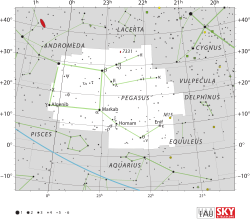Scheat
Scheat eller Beta Pegasi (β Peg, β Pegasi) er ei raud kjempestjerne i stjernebiletet Pegasus. Den tilsynelatande storleiksklasse er 2,42, som gjer ho til den nest mest lyssterke i stjernebiletet etter Epsilon Pegasi.
| Observasjonsdata Epoke J2000 Ekvinoks J2000 | |
|---|---|
| Stjernebilete | Pegasus |
| Rektascensjon | 23h 03m 46.45746s[1] |
| Deklinasjon | +28° 04′ 58.0336″[1] |
| Karakteristikk | |
| Spektralklasse | M2.3 II-III[2] |
| U−B fargeindeks | +1.96[3] |
| B−V fargeindeks | +1.67[3] |
| Variabel type | Halvregulær[4] |
| Astrometri | |
| Radialsnøggleik (Rv) | +8.7[5] km/s |
| Parallakse (π) | 16.64 ± 0.15[1] mas |
| Avstand | 196 ± 2 ly (60,1 ± 0,5 pc) |
| Absolutt storleiksklasse (MV) | -1.49 |
| Detaljar | |
| Masse | 2.1[6] M☉ |
| Radius | 95[7] R☉ |
| Overflategravitasjon (log g) | 1.20[8] cgs |
| Temperatur | 3,689[8] K |
| Metallisitet [Fe/H] | –0.11[8] dex |
| Rotasjonssnøggleik (v sin i) | 9.7[9] km/s |
| Andre namn | |
| Databasereferanse | |
| SIMBAD | data |
Basert på parallaksemålingar ligg Beta Pegasi kring 196 lysår.[1] Ho er uvanleg for å vere ei lyssterk stjerne fordi ho har ein relativt låg overflatetemperatur, samanlikna med stjerner som sola.[7] Denne stjerna har ein spektralklasse på M2.3 II-III,[2] som indikerer at spektrumet har eigenskapar mellom ei lyssterk kjempe og ei kjempestjerne. Ho har utvida seg til å bli 95 gonger så stor som sola og ho lyser 1500 gonger så sterkt.[7] Den effektive temperaturen til den ytre envelopen til stjerna er kring 3 700 K,[8] og gjev stjerna ein karakteristisk oransje-raud farge til ei klasse M-stjerne.[10]
Beta Pegasi er ein halvregulær variabel med ein periode på 43,3 dagar[4] med ein lysstyrke som varierer frå +2,31 til +2,74.[11]
Kjelder endre
- Denne artikkelen bygger på «Scheat» frå Wikipedia på engelsk, den 9. juli 2016.
- ↑ 1,0 1,1 1,2 1,3 van Leeuwen, F. (November 2007), «Validation of the new Hipparcos reduction», Astronomi and Astrophysics 474 (2): 653–664, Bibcode:2007A&A...474..653V, arXiv:0708.1752, doi:10.1051/0004-6361:20078357
- ↑ 2,0 2,1 2,2 «V* bet Peg -- Pulsating variabel Star», SIMBAD (Centre de Données astronomiques de Strasbourg), henta 16. oktober 2014
- ↑ 3,0 3,1 Johnson, H. L.; et al. (1966). «UBVRIJKL photometry of the bright stars». Communications of the Lunar and Planetary Laboratory 4 (99). Bibcode:1966CoLPL...4...99J.
- ↑ 4,0 4,1 Tabur, V.; et al. (desember 2009), «Long-term photometry and periods for 2,1 nearby pulsating M giants», Monthly Notices of the Royal Astronomical Society 400 (4): 1945–1961, Bibcode:2009MNRAS.400.1945T, arXiv:0908.3228, doi:10.1111/j.1365-2966.2009.15588.x
- ↑ Wilson, Ralph Elmer (1953), General Catalogue of Stellar Radial Velocities, Washington: Carnegie Institution of Washington, Bibcode:1953QB901.W495.....
- ↑ Tsuji, Takashi (May 2007), «Isotopic abundances of Carbon and Oxygen in Oxygen-rich kjempestjerner», i Kupka, F.; Roxburgh, I.; Chan, K., Convection in Astrophysics, Proceedings of IAU Symposium #239 held 21-25. august, 2006 in Prague, Czech Republic, s. 307–310, Bibcode:2007IAUS..239..307T, arXiv:astro-ph/0610180, doi:10.1017/S1743921307000622
- ↑ 7,0 7,1 7,2 Kaler, James B. (May 22, 2009), «SCHEAT (Beta Pegasi)», Stars (University of Illinois), henta 16. oktober 2014
- ↑ 8,0 8,1 8,2 8,3 Soubiran, C.; et al. (2008), «Vertical distribution of Galactic disk stars. IV. AMR and AVR from clump giants», Astronomi and Astrophysics 480 (1): 91–101, Bibcode:2008A&A...480...91S, arXiv:0712.1370, doi:10.1051/0004-6361:20078788
- ↑ Massarotti, Alessandro; et al. (January 2008), «Rotational and Radial Velocities for a Sample of 7,1 HIPPARCOS Giants and the Role of Binarity», The Astronomical Journal 135 (1): 209–231, Bibcode:2008AJ....135..209M, doi:10.1088/0004-6256/135/1/209
- ↑ «The Colour of Stars», Australia Telescope, Outreach and Education (Commonwealth Scientific and Indianarentrial Research Organisation), desember 21, 2004, henta 13. juni 2016[daud lenkje]
- ↑ «Query= bet Peg», General Catalogue of Variable Stars (Centre de Données astronomiques de Strasbourg), henta 16. oktober 2014
